Exploring the Spaces in Between at the Prague Quadrennial
by Amanda Wambach
This summer I had the privilege to attend the Prague Quadrennial with the help of the Northern Boundaries Section of USITT. Prague Quadrennial is the largest Scenography event in the world, bringing 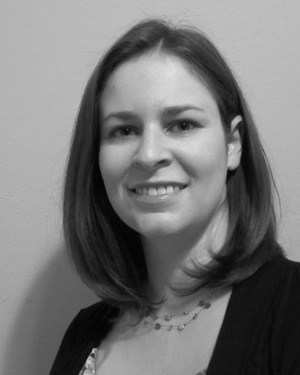 together thousands of artists from around the world to share and explore in the latest work in visual and performance art. It was a collection of lectures, discussions, performances, exhibits, and interactions (many were a combination of one or more of these) that were held all over the city and covered all areas of performance design: scenery, costumes, lighting, sound, media, film, dance, puppetry, performance space and theatre architecture. The main event was the International Competitive Exhibition in which over 70 countries curated installations showcasing their latest work in scenography. It included both professional exhibits and a student section of exhibits, as well as a costume competition called Extreme Costume. The expo held a remarkable mixture of people, culture, design, and performance. There was a great variety in work presented by each country and in the approach to each exhibit. Some countries chose simply to showcase the work of one or more designers, some were performances spaces, some were interactive events, some were art installations focusing on a single theme, and some were many of these at once. More will be shared about the International Exhibition at the upcoming NBS conference at Hamline University.
together thousands of artists from around the world to share and explore in the latest work in visual and performance art. It was a collection of lectures, discussions, performances, exhibits, and interactions (many were a combination of one or more of these) that were held all over the city and covered all areas of performance design: scenery, costumes, lighting, sound, media, film, dance, puppetry, performance space and theatre architecture. The main event was the International Competitive Exhibition in which over 70 countries curated installations showcasing their latest work in scenography. It included both professional exhibits and a student section of exhibits, as well as a costume competition called Extreme Costume. The expo held a remarkable mixture of people, culture, design, and performance. There was a great variety in work presented by each country and in the approach to each exhibit. Some countries chose simply to showcase the work of one or more designers, some were performances spaces, some were interactive events, some were art installations focusing on a single theme, and some were many of these at once. More will be shared about the International Exhibition at the upcoming NBS conference at Hamline University.
I particularly enjoyed the great variety in exhibits found throughout the Quadrennial. Edward Gordon Craig: Space and Light, was tucked into 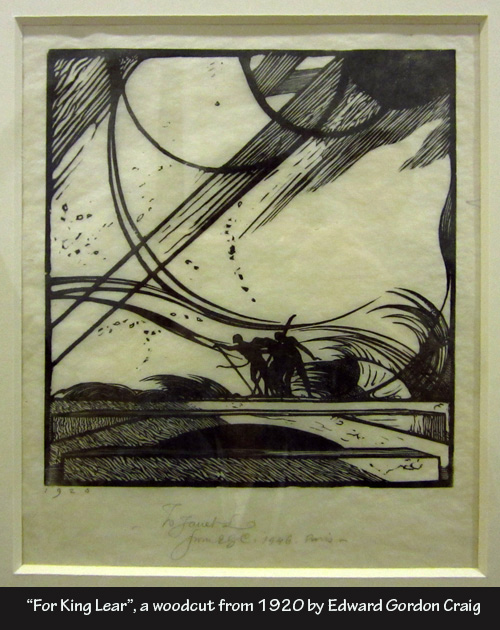 a small art gallery. This was the only exhibit featuring an historic artist, and displayed a collection of some of Craig’s lesser known work. It was a quaint and quiet gallery featuring some really beautiful woodcuts and drawings from the early 20th century. In contrast, the plaza of the National Theatre held the exhibit Intersection: Intimacy and Spectacle. This exhibit let the viewer make their own path through a three dimensional maze of boxes. As I made my way through I encountered a fantastically textured
a small art gallery. This was the only exhibit featuring an historic artist, and displayed a collection of some of Craig’s lesser known work. It was a quaint and quiet gallery featuring some really beautiful woodcuts and drawings from the early 20th century. In contrast, the plaza of the National Theatre held the exhibit Intersection: Intimacy and Spectacle. This exhibit let the viewer make their own path through a three dimensional maze of boxes. As I made my way through I encountered a fantastically textured
room made entirely of white undergarments. I watched a professional dancer giving tango lessons to a small boy who was more interested in 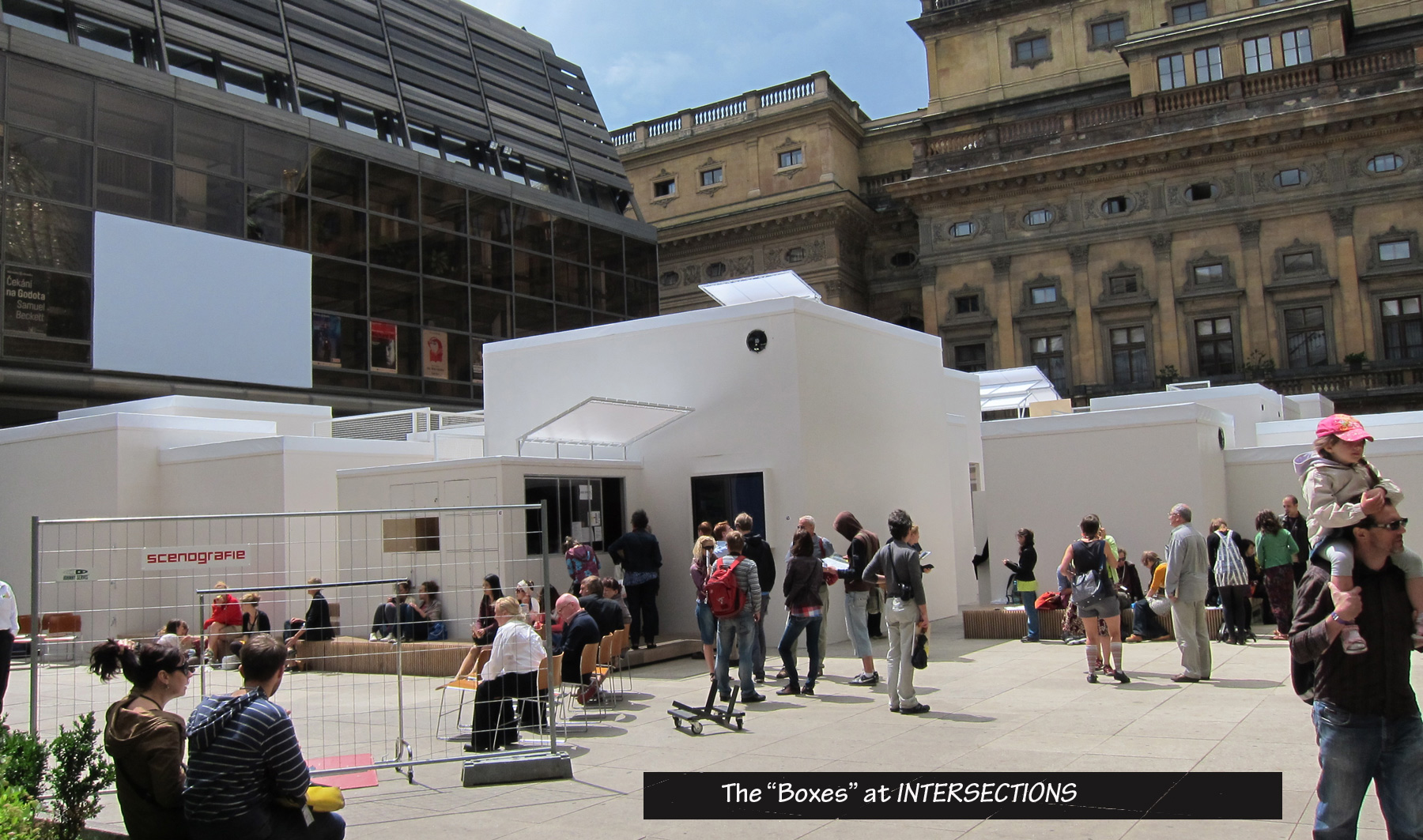 his own dance moves. A group of actors rushed past me reading from a computer generated reshuffling of classic literature. In one box I
his own dance moves. A group of actors rushed past me reading from a computer generated reshuffling of classic literature. In one box I 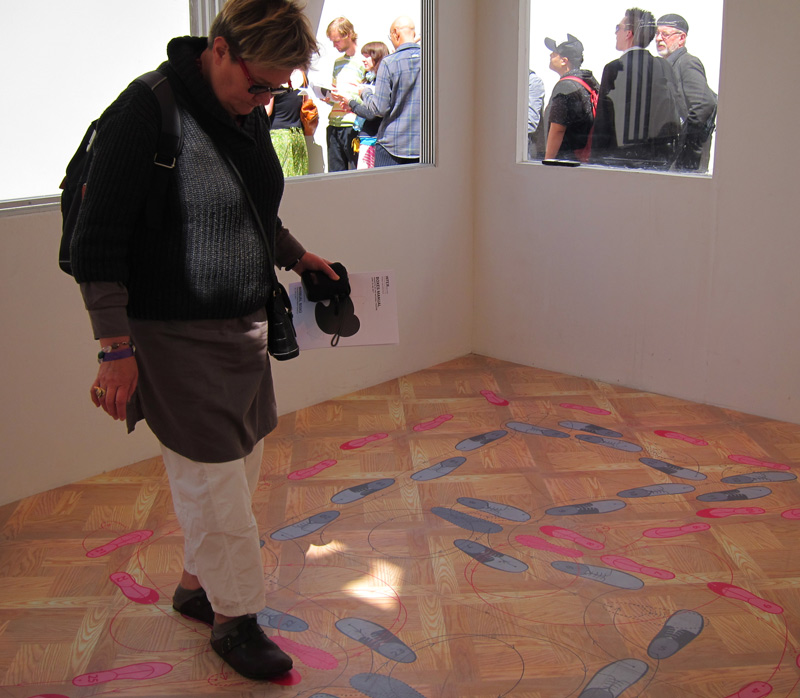 found two women lying on the floor talking so quietly that I had to invade their personal space to hear what they were saying. Another box was handing out outrageous costumes to patrons. I watched a couple holding each other through a glass window. Following the sound of club music, I got my hand stamped and entered into a mirrored room equipped with a disco ball and colored lights. I joined the rave for a
found two women lying on the floor talking so quietly that I had to invade their personal space to hear what they were saying. Another box was handing out outrageous costumes to patrons. I watched a couple holding each other through a glass window. Following the sound of club music, I got my hand stamped and entered into a mirrored room equipped with a disco ball and colored lights. I joined the rave for a 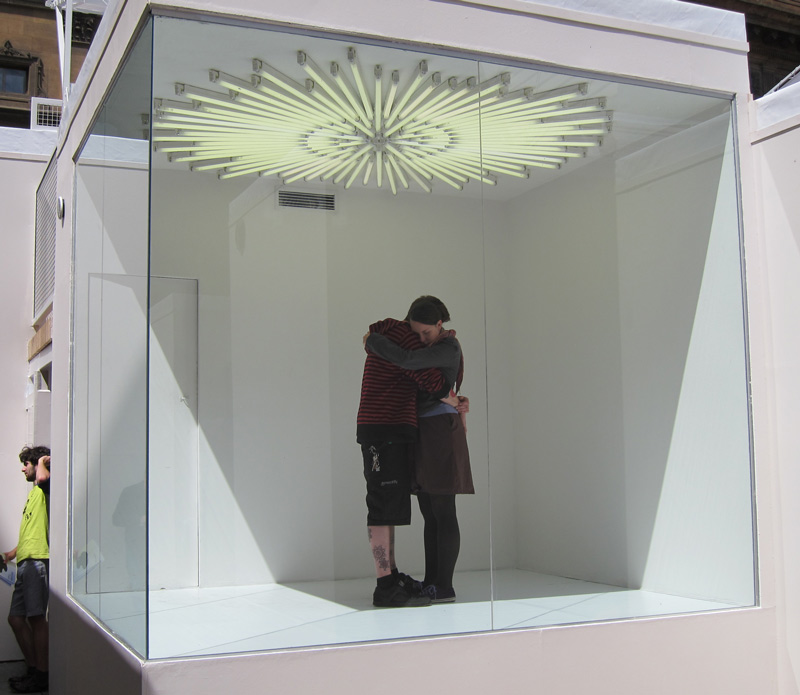 few dances, and then headed up to the roof for a cold beverage. It was a jarring and fascinating hodgepodge of performance and exhibit, intimacy and spectacle.
few dances, and then headed up to the roof for a cold beverage. It was a jarring and fascinating hodgepodge of performance and exhibit, intimacy and spectacle.
Scenofest was an integrated part of the Quadrennial with a focus on students. Six Acts, Design as Performance, and workshops were the three main avenues for students to participate in this educational exchange. Each of these opportunities brought together a small multi-national group of students and was led by internationally renowned professionals. As I’ve never been very interested in being a performer, I opted to participate in one of the workshops, which covered a vast array of topics in as many disciplines. Students were able to choose 3 – 5 workshops that interested them, and then were assigned to one. How to Make a Dance Costume from Bamboo, Interactive Theatre, Light Shining Through: Intersection of Analogue and Digital 3D Space, From Image to Text, The Intersection of Costume and Sound in Character, Goofing Off: Poem Solo Performance, A Theatre of Trash, Soundscape and Story, Meet the Experts, From Prop to Protagonist, and The Artist as Magician, are only a small selection of titles to illustrate the inter-disciplinary nature and variety in content and approach to these workshops. I found that a little research into the presenters of these workshops helped me to narrow the choices and to find what was right for me.
The workshop that I participated in was Creative Performance Design and was led by Mónica Raya. Mónica is a scenic, lighting, costume designer and director from Mexico City. She did her graduate work at Yale School of Drama, designed countless productions in the US and Mexico, and has been featured in Prague Quadrennial and in other international scenography exhibits. Mónica started the discussion by asking each of us what we were looking for. From our interests and desires she came up with a list that revealed the commonality of the group. We were all interested in multiple disciplines within performance and design, and we were all connected be a desire to do something that we hadn’t encountered yet or could not define. We were all looking for a space in between. She used what we had given her to encourage us to broaden our knowledge rather than specializing in one area. This really resonated with me because I came to graduate school to broaden my skill set, and it was refreshing to be encouraged to pursue my many interests rather than fit into one box or another. I don’t have to be just a scenic designer. I can create for myself the space I need to work on what fascinates me. I knew I wasn’t alone in this because as everyone realized they were not alone, the sigh of relief was palpable. Mónica had an approach to creative performance design that simultaneously capitalized on this desire and challenged much of what is taught in a traditional design school.
Mónica used simple definitions to challenge the common understanding of achievement. She started with creativity by encouraging us to fail. “You are taught all your lives that to be unsafe is bad, that failure is bad, that you must succeed, but it is through adversity and uncertainty that we become creative.” If we fail, it means we tried something new and gained some experience and perspective. She used a simple definition of performance to open the door to new possibilities. Performance is an act, an execution. Just as a play, a concert, or an opera is a performance, so too is a football game, a class, or a design. “So act!” She said, “Don’t wait for the outside to give you answers. Come down from the tower and slay your own dragons.” Then, Monica let us in on her little secret; she hates the theatre. Most of our design schools teach design on a proscenium stage, and we work at creating a stage picture. But performance and design happen in space. Design is more that art on a wall, because it must perform. It has to work whether supporting a story or influencing the human condition. And as she went on to quote Peter Brook, “Give me an empty space and I will give you a theatre,” she was setting us up for an invigorating challenge to think outside the black box of the theatre.
For the second part of the workshop we had been asked to bring in ideas about Samuel Beckett’s play Waiting for Godot. A flurry of activity began as we created chalk drawing on the classroom walls, and used chairs, tape, and whatever else we could find to model ideas. But before we jumped into presentations we settled in for a brainstorming session for creating a mise en scène. We came up with many examples of some basic elements (space, structure, design, a creative 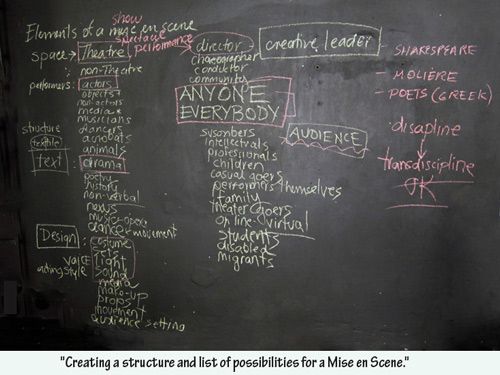 leader, an audience, and production) which became a tool for thinking about the play in a holistic way.
leader, an audience, and production) which became a tool for thinking about the play in a holistic way.
The first person to present was the most eager kid in the room. He came in with many ideas that were similar to the rest of the group. A play following the script, performed by actors, lead by a director, himself as a designer, in a theatre, with action centered on a large sculptural tree. Mónica continually interrupted him (as promised) and used our mise en scène structure to force him to think about the things he missed and to challenge what he thought he knew. Why does the play have to take place in a theatre? How are you going to get from your idea to a finished product? Is it easier to move the dirt into the 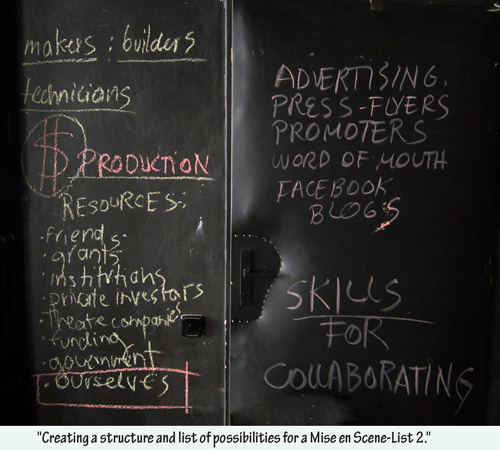 theatre or the chairs to an outdoor space? Why can’t we change the script if it serves the idea better? Do we need actors? Why not acrobats or puppets? How do you know it won’t serve the play, have you tried it? Who is the creative leader? Why not you? Do you need to be a director to be a creative leader? Who is the audience and how are you going to affect them? How are you going to get people to come? Mónica grilled this first brave soul to set up the group to be prepared to explore the unknown while simultaneously experiencing the uncertainty and fear that goes along with it. He had started out excitedly describing his idea, sure that he was right he defended it, as the group jumped in with alternatives he became less sure of himself, but in the end he had more confidence than he started with. Most importantly, he had let go of what he thought he knew and let the group participate in his idea, which became richer and more developed. In all the design presentations I have participated in, I have never seen a person change their thinking or a group come together so quickly, and it was an extraordinary thing to be a part of.
theatre or the chairs to an outdoor space? Why can’t we change the script if it serves the idea better? Do we need actors? Why not acrobats or puppets? How do you know it won’t serve the play, have you tried it? Who is the creative leader? Why not you? Do you need to be a director to be a creative leader? Who is the audience and how are you going to affect them? How are you going to get people to come? Mónica grilled this first brave soul to set up the group to be prepared to explore the unknown while simultaneously experiencing the uncertainty and fear that goes along with it. He had started out excitedly describing his idea, sure that he was right he defended it, as the group jumped in with alternatives he became less sure of himself, but in the end he had more confidence than he started with. Most importantly, he had let go of what he thought he knew and let the group participate in his idea, which became richer and more developed. In all the design presentations I have participated in, I have never seen a person change their thinking or a group come together so quickly, and it was an extraordinary thing to be a part of.
As the challenges built, so did the possibilities for Waiting for Godot. We imagined Waiting for Godot as an event – a carnivalin a warehouse or abandoned train station featuring acrobats as rustic clowns inspired by the characters of the piece. We thought about waiting for Godot in an airport. It became a series of sculptures for the blind at one point. Not every idea had merit or was even feasible, but creativity builds. As more and more people stood up to take their turn original ideas were clearly influenced just by being in the room. We conceived of the play as part of a theatre festival with a setting of a pedestrian only street flanked by two cafés. The audience would be seated in the cafes watching an adaptation of the play enfold as pedestrians walk through the action. Vladimir and Estragon do not notice these people as they wait for Godot, but would pedestrians interact with two seemingly homeless men on a park bench? And soon we were taking a vague idea and shaping it as a group. We could do Waiting for Godot on a cliff looking over a city. This brought up the important question of how to get an audience to a cliff top. We could bus the audience to the space. What if the bus drivers were the characters in the play? The journey became part of the play. What if it’s cold? Maybe the audience members are given jackets that look like the characters. Now the audience has become part of the story. What if there are turnips and carrots in the pockets? And so on… We started the day as a room full of strangers, and eight hours we were all colleagues sharing ideas. That is what I love about theatre. It can bring people together, overcome obstacles, and create a community.
Waiting for Go dot was a poetic choice because the workshop was about anything but. The workshop left me inspired to take chances on my own ideas, it renewed my love for collaborative work, and it opened my mind to new possibilities. I came in thinking of myself as a scenic designer and left making plans to execute my wildest dreams. Creative Performance Design was an experiment in new ways to think about scenography, and the hundreds of events that made up the Prague Quadrennial was a great opportunity to experience it.
